Among the dozens of honey locust varieties, two of the most similar in physical features are Shademaster and Sunburst. It's very difficult to distinguish the qualities of each, especially during the fall season when the leaf colors are similar. To help you out with identification, we researched the distinct qualities of these two varieties, and here's what we learned.
What makes the Shademaster and Sunburst Honey Locust tree varieties differ and distinct from each other are the following traits:
Sunburst
- Golden yellow young leaves at the tip of the branches
- Single v-crotch branch at the top of the trunk
Shademaster
- Dark green foliage but turns yellow during the fall season
- Grows finer branches
- Broad v-shaped crotches
Read on below as we further discuss the characteristic differences of each honey locust variety and generally how long these trees can live.
Shademaster Vs. Sunburst Honey Locust
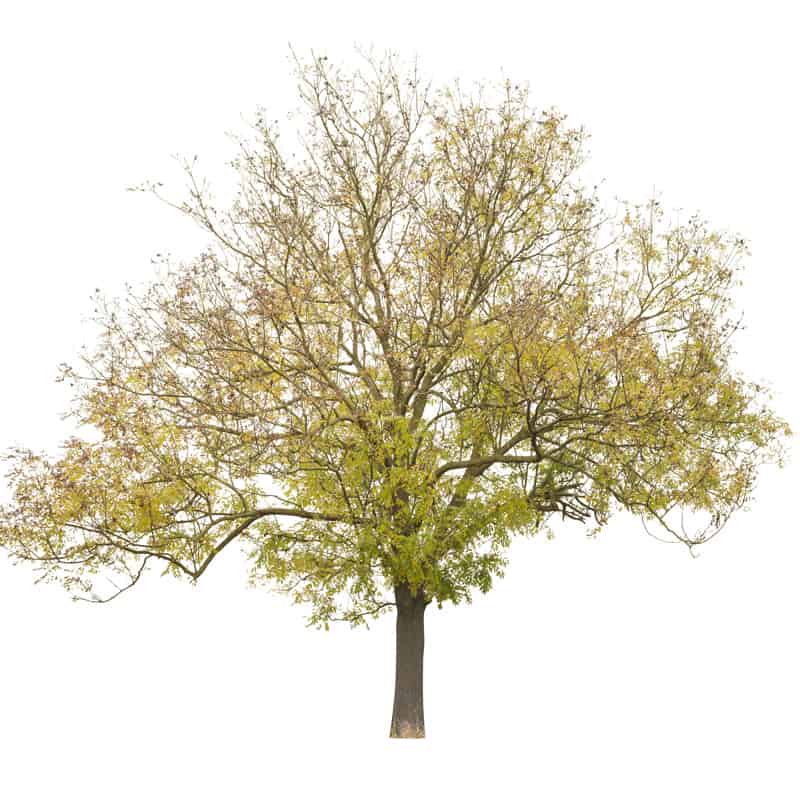
Honey locusts are fast-growing and hardy trees native to the United States. Because it can tolerate drought, storm, and salinity, it is often planted to form windbreaks and as a remedy for soil erosion.
The wood is durable and often used in carpentry for furniture, fence posts, and certain structures. The thornless and fruitless varieties are used for landscaping and ornamental purposes.
Currently, there are more than a dozen varieties of this tree. We're going to identify the distinct features and differences between the Shademaster and Sunburst varieties.
If you want to tell whether a honey locust tree is a Shademaster or a Sunburst, here are their main features, similarities, and differences:
Sunburst
- Irregular growth habit
- Can be identified with the gold-tipped young foliage
- Pyramidal head
- Single v-crotch branch up the trunk
Shademaster
- Straight bottom branches
- Upright vase-shaped tree
- Dark green foliage
- Rectangular pyramidal head
- Fine branches
- Flat top
- Broad v-shaped crotches
What Is A Sunburst Honey Locust Tree?
Scientific name: Gleditsia triacanthos 'Sunburst’
The Sunburst honey locust is a highly popular tree because of its distinct yellow-colored leaves that can fade to light green. It is a favorite ornamental tree because it provides shade and color accent to landscaping.
Branches
The Sunburst is a medium-sized tree with irregular growth patterns. This means that its branching is unpredictable and its shape is not consistent as it grows over the years.
Although its branches grow randomly, it has an unmistakable winding pattern with thornless stems. The lower branches will be upright but the higher branches will be crossed and have an irregular growth pattern.
The texture of the branch is coarser compared to other honey locust varieties. This means that during strong storms, the smaller branches can easily break and bend. However, the bigger branches may remain undisturbed.
Leaves
Sunburst honey locust is most identifiable with its yellow foliage. The color is even more noticeable with its new leaf growth that grows a bright golden yellow.
See the picture below of the Sunburst tree growing young leaves in yellow and older leaves in yellow-green.
The yellow color is most prominent during springtime and the early growing season. Its yellow color usually outlines the entire tree's pyramidal-shaped head. This tree variety grows a lot of bunchy flower buds during the colder seasons.
Another identifiable feature that is very common among all Sunburst honey locusts is their single v-crotch branch at the top part of the trunk.
A tree crotch is the meeting point between two branches or the tree's trunk and limb. Trees can either have a U shape or a V shape (also called Y shape). Honey locust trees have V-shaped crotches.
How Big Does Sunburst Honey Locust Get?
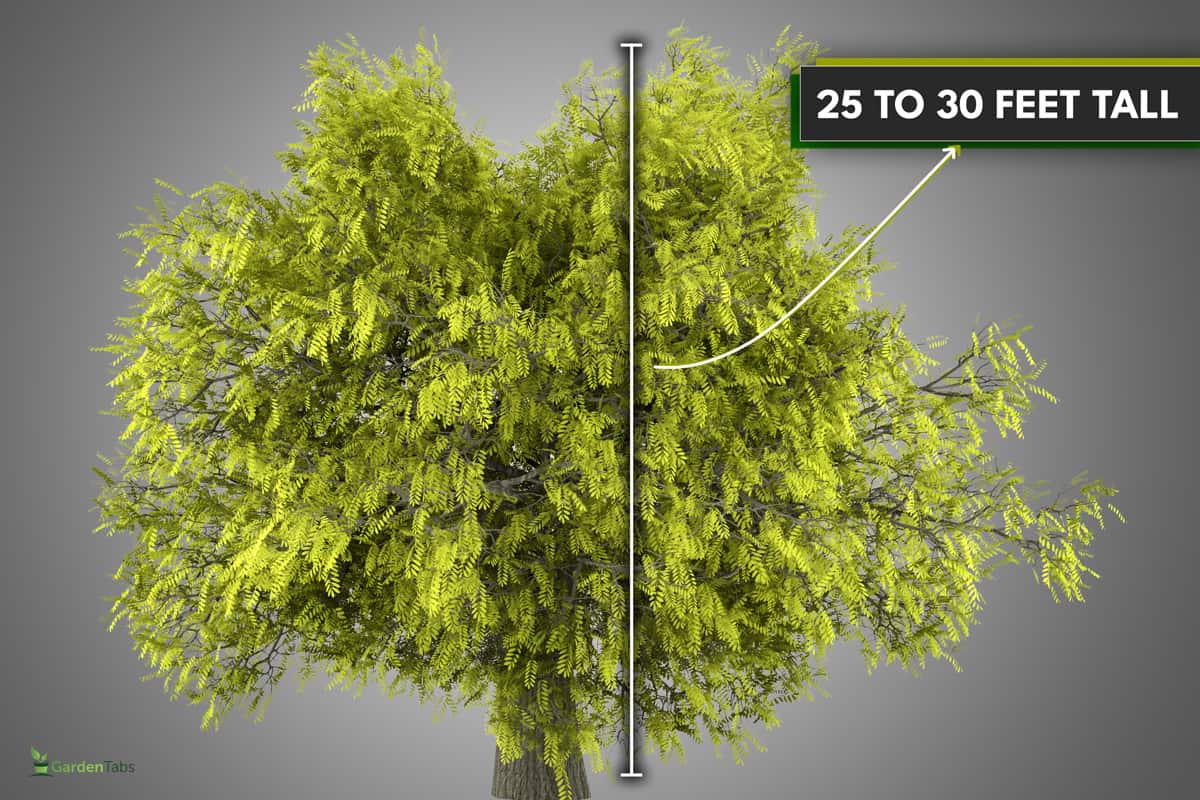
A Sunburst honey locust tree can grow to a height of 25 to 30 feet tall and just about the same feet wide. It grows best in moist conditions and adapts best in loam soil.
What Is A Shademaster Locust?
Scientific name: Gleditsia triacanthos var. inermis ‘Shademaster’
The Shademaster honey locust tree is a medium-sized upright tree with rectangular pyramidal foliage. Its branches are widely spaced and grow small, fern-like leaves.
The Shademaster is a favorite lawn tree among landscaping professionals because it is hardy and does not have thorns, unlike other honey locusts.
It can be planted anywhere, whether out in the country or even in the middle of a bustling city because it is unaffected by soot, salt, and pollution.
Branches
Shademaster trees produce finer and thinner branches with twig extensions growing 13.5 inches per year. Its bottom branches grow straight and angled upwards and create broad-shaped v-crotches.
The upper part of the trees are flatter, creating the perfect shape for providing shade and giving it its name. The tree needs very little pruning to build a strong tree structure.
Leaves
This tree produces dark green foliage all throughout the summertime. It has very small leaves that will drop during fall and autumn. However, there's no need to bring out the rake. The leaf drops are manageable and won't require any major equipment to clean up.
The leaves' fern-like appearance and the tree's broad branches make it ideal for providing shade. Its leaves are soft and airy and provide soft shade below it.
A Honey Locust is basically seedless, so it's very low maintenance. However, it will sometimes produce flowers that are reddish in color and seed pods of about 10 inches long. These pods will often appear when the tree is 15 years old or older.
How Fast Does A Shademaster Locust Grow?
The Shademaster honey locust will grow about 2 to 4 feet per year for the first 15 years of its life. It can grow up 50 to 70 feet tall at its full height and just as wide. This means that when allowed to grow under ideal conditions it can grow to a spread of 35 to 50 feet wide.
How Far Apart Should Honey Locust Trees Be Planted?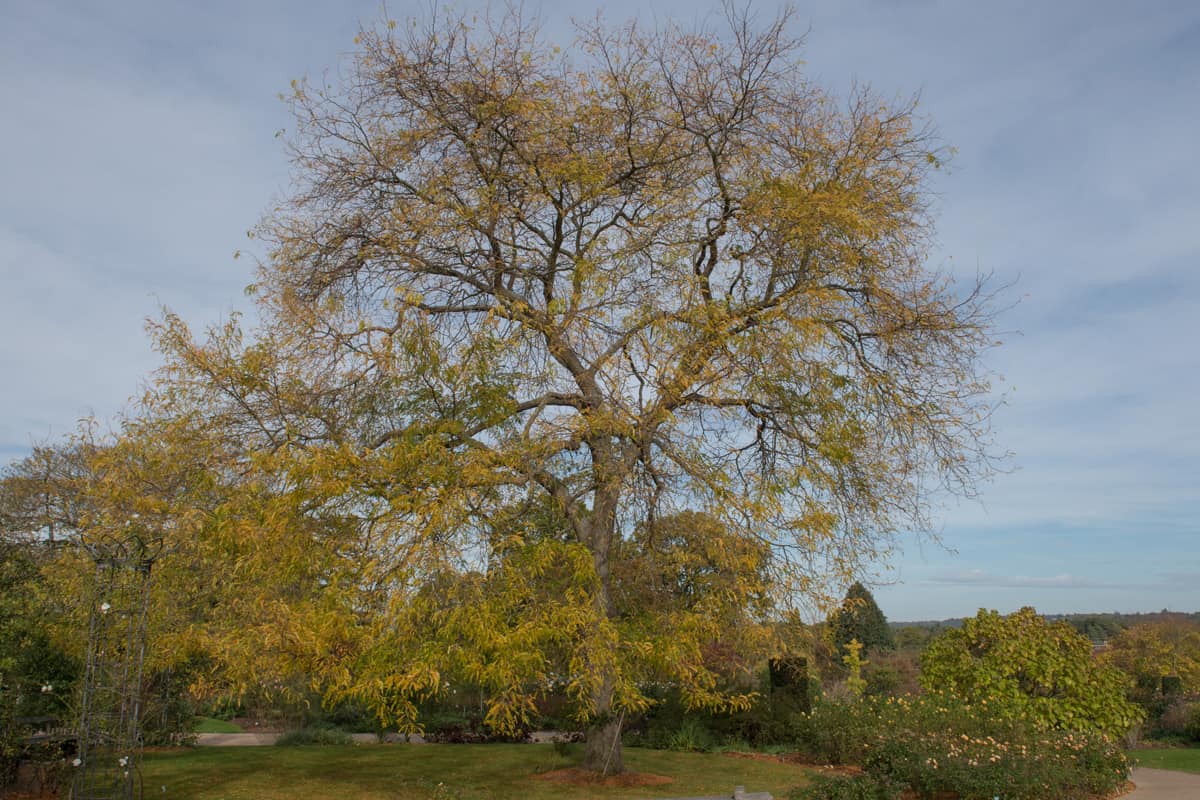
Are you planning to plant several honey locust trees? You need to remember that even though these trees are medium-sized, their branches grow broad and wide. Therefore, you need to properly plan how far apart you should plant them.
If you want to keep them slightly close to each other, it is recommended to plant them around 20 to 30 feet apart.
However, you should plant them a little further apart, especially if you're planning to plant a Shademaster. As mentioned above, its spread can grow up to 50 feet wide, so pruning will be necessary if you want to cluster them.
If you're planning to plant them as windbreaks, you can plant them 10 to 15 feet apart. At this space, they can form a cluster barrier without impeding each other's growth.
Check out this thornless honey locust tree seeds on Amazon.
Is Honey Locust A Messy Tree?
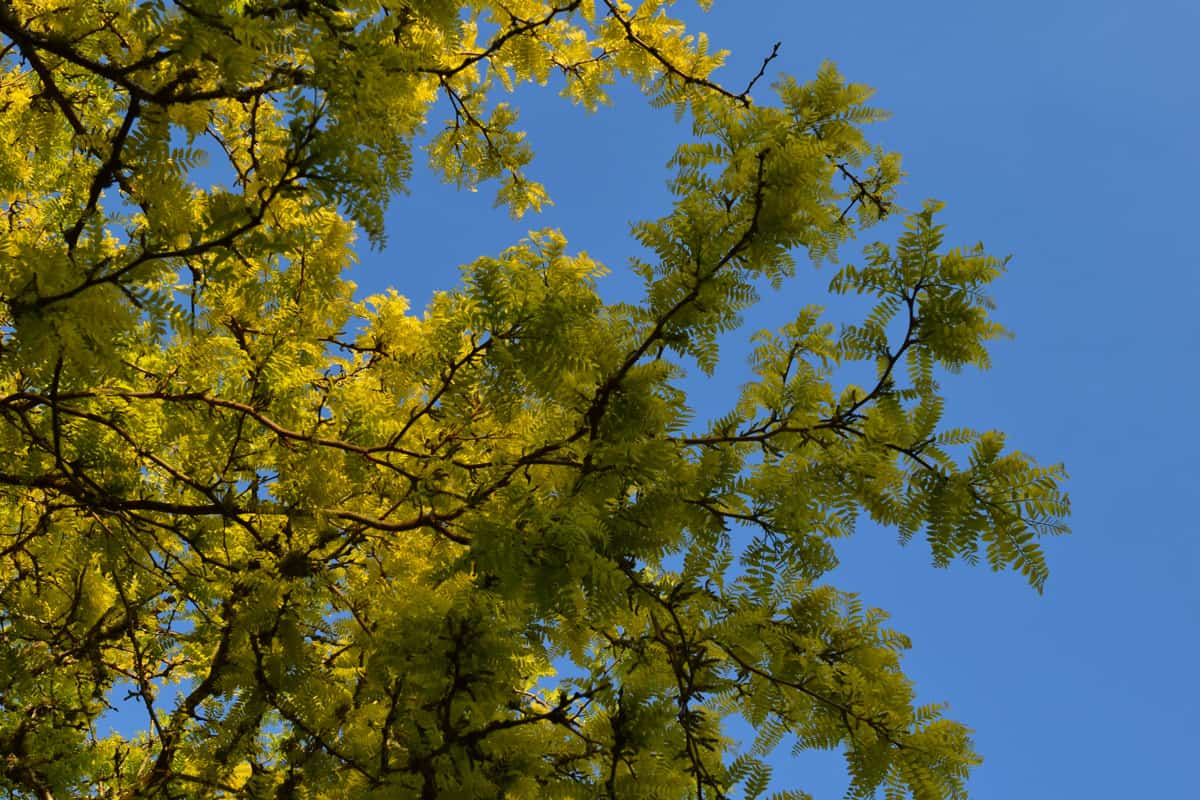
Honey locusts are considered non-messy trees. The development of podless and thornless varieties means it makes very few "drops" on the ground. The drops refer to leaves, pods, fruits, leaves, seeds, or anything else the tree produces that eventually falls on the ground when it ripens or dries.
Being non-messy also means honey locusts do not attract wildlife that can potentially cause more mess in the area.
This is the reason why honey locust trees are a favorite among horticulturists when doing landscaping. They are clean trees that need very little maintenance. There's no need to frequently clean or use special equipment to clean up large amounts of leaves.
Are Honey Locust Tree Roots Invasive?
Honey locusts are considered an invasive and aggressive type of tree, particularly those with pods and seeds. This is because it is hardy, fast-growing, and can survive most types of environments.
Its roots grow deep and spread widely. In fact, it can penetrate soil up to 6 meters down. That's why it is not ideally planted in areas where it can damage buried cables, wires, and pipes.
On the brighter side, its deep roots allow it to be an ideal tree to remedy soil erosion and to form windbreaks in areas frequented by storms, strong winds, and harsh weather conditions.
What Is The Lifespan Of A Honey Locust Tree?
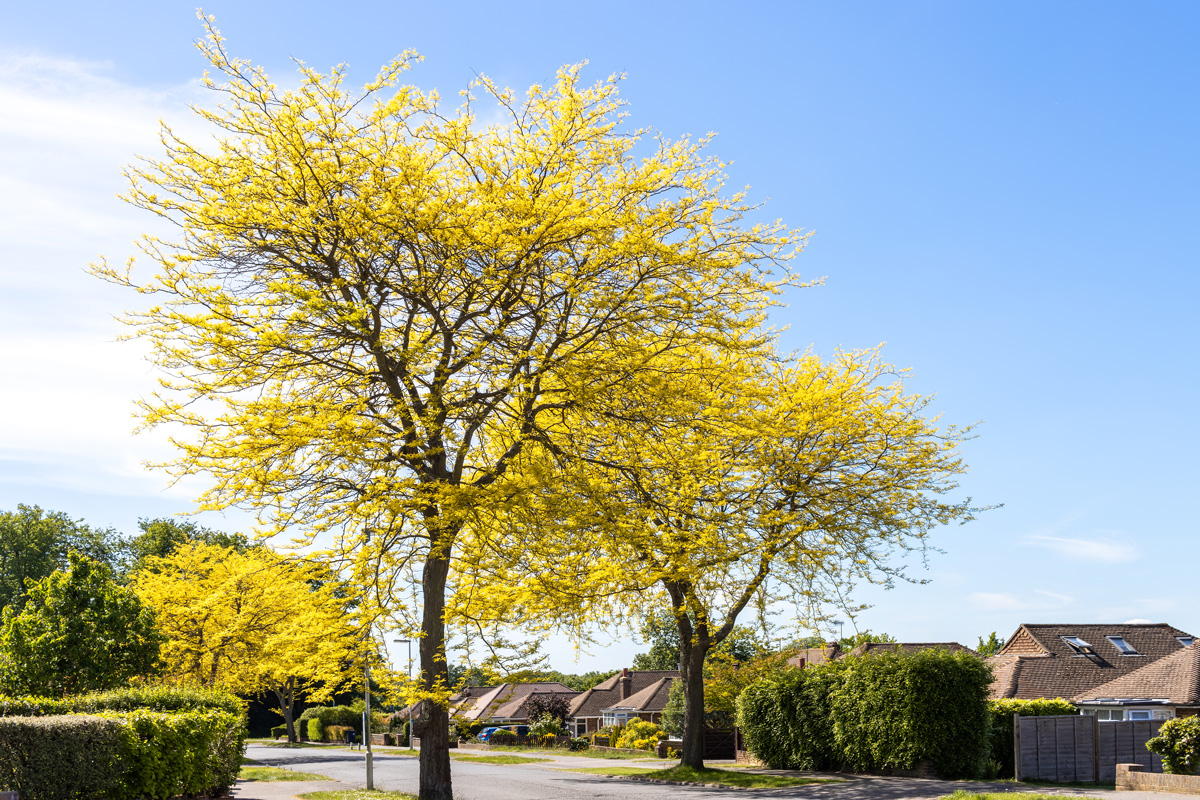
The average lifespan of a honey locust tree is 125 years, but there are many recorded accounts of honey locusts all over the world that have lived longer.
The oldest recorded honey locust tree in the world is around 239 years old. It is located at the Cemetery Kozia Brana in Slovakia.
Wrapping Up
The Sunburst honey locust tree can be identified by its bright golden-yellow young leaves, pyramidal head, and single v-shaped crotch.
The Shademaster locust will have greener foliage which only turns yellow during fall, a rectangular pyramidal head, and a broad v-shaped crotch.
Thank you very much for reading through. We hope you were able to distinguish the differences between a Sunburst and a Shademaster honey locust tree.
For more information on honey locust trees, you can check out these other articles below.
Do Honey Locust Trees Have Thorns?

